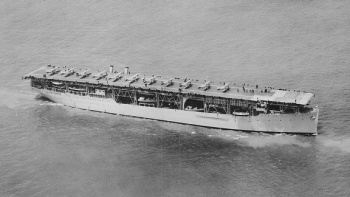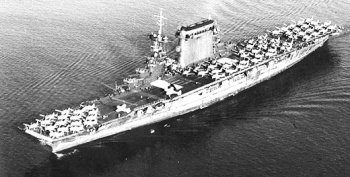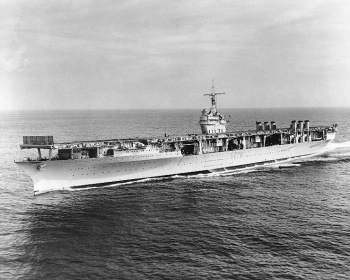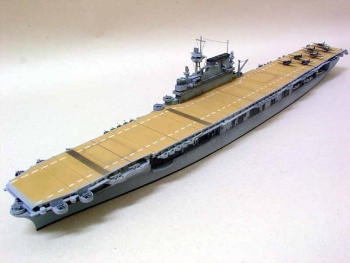Post by Diarist on Jan 23, 2015 17:04:49 GMT 1
USS Langley (CV-1)
USS Langley (CV-1) is the United States Navy's first aircraft carrier, converted in 1920 from the collier USS Jupiter (AC-3), and also the U.S. Navy's first electrically propelled ship. Conversion of another collier was planned but cancelled when the Washington Naval Treaty required the cancellation of the partially built battlecruisers Lexington and Saratoga, freeing up their hulls for conversion to the aircraft carriers CV-2 and CV-3. Langley was named after Samuel Pierpont Langley, an American aviation pioneer.
Service history
Collier
President William H. Taft attended the ceremony when Jupiter's keel was laid down on 18 October 1911 at the Mare Island Naval Shipyard in Vallejo, California. She was launched on 14 August 1912 sponsored by Mrs. Thomas F. Ruhm; and commissioned on 7 April 1913 under Commander Joseph M. Reeves. Her sister ships were Cyclops, which disappeared without a trace during the war, Proteus, and Nereus.
After successfully passing her trials, Jupiter embarked a United States Marine Corps detachment at San Francisco, California, and reported to the Pacific Fleet at Mazatlan, Mexico on 27 April 1914, bolstering U.S. naval strength on the Mexican Pacific coast in the tense days of the Veracruz crisis. She remained on the Pacific coast until she departed for Philadelphia on 10 October. En route, the collier steamed through the Panama Canal on Columbus Day, the first vessel to transit it from west to east.
Prior to America's entry into the Great War, she cruised the Atlantic and Gulf of Mexico attached to the Atlantic Fleet Auxiliary Division. The ship arrived at Norfolk, Virginia on 6 April 1917, and, assigned to the Naval Overseas Transport Service, interrupted her coaling operations by two cargo voyages to France in June 1917 and November 1918. The first voyage transported a naval aviation detachment of 7 officers and 122 men to England. It was the first U.S. aviation detachment to arrive in Europe and was commanded by Lieutenant Kenneth Whiting, who became Langley's first executive officer five years later. Jupiter was back in Norfolk on 23 January 1919 whence she sailed for Brest, France on 8 March for coaling duty in European waters to expedite the return of victorious veterans to the United States. Upon reaching Norfolk on 17 August, the ship was transferred to the West Coast. Her conversion to an aircraft carrier was authorized on 11 July 1919, and she sailed to Hampton Roads, Virginia on 12 December, where she decommissioned on 24 March 1920.
Carrier
Jupiter was converted into the first U.S. aircraft carrier at the Navy Yard, Norfolk, Virginia, for the purpose of conducting experiments in the new idea of seaborne aviation. On 11 April 1920, she was renamed Langley in honour of Samuel Pierpont Langley, an American astronomer, physicist, aeronautics pioneer and aircraft engineer, and she was given hull classification symbol CV-1. She recommissioned on 20 March 1922 with Commander Kenneth Whiting in command.
As the first American aircraft carrier, Langley was the scene of numerous[citation needed] momentous events. On 17 October 1922, Lt. Virgil C. Griffin piloted the first plane—a Vought VE-7—launched from her decks. Though this was not the first time an airplane had taken off from a ship, and though Langley was not the first ship with an installed flight deck, this one launching was of monumental importance to the modern U.S. Navy. The era of the aircraft carrier was born. With Langley underway nine days later, Lieutenant Commander Godfrey de Courcelles Chevalier made the first landing in an Aeromarine 39B. On 18 November, Commander Whiting was the first aviator to be catapulted from a carrier's deck.
An unusual feature of Langley was provision for a carrier pigeon house on the stern between the 5 in (130 mm)/51 cal guns. Pigeons had been carried aboard seaplanes for message transport since the Great War, and were to be carried on aircraft operated from Langley. The pigeons were trained at the Norfolk Naval Shipyard while Langley was undergoing conversion. As long as the pigeons were released a few at a time for exercise, they returned to the ship; but when the whole flock was released while Langley was anchored off Tangier Island, the pigeons flew south and roosted in the cranes of the Norfolk shipyard. The pigeons never went to sea again and the former pigeon house became the executive officer's quarters; but the early plans for conversion of Lexington and Saratoga included a compartment for pigeons.
By 15 January 1923, Langley had begun flight operations and tests in the Caribbean Sea for carrier landings. In June, she steamed to Washington, DC, to give a demonstration at a flying exhibition before civil and military dignitaries. She arrived at Norfolk on 13 June, and commenced training along the Atlantic coast and Caribbean which carried her through the end of the year. In 1924, Langley participated in more maneuvers and exhibitions, and spent the summer at Norfolk for repairs and alterations, she departed for the west coast late in the year and arrived San Diego, California on 29 November to join the Pacific Battle Fleet.
In 1927, the USS Langley was at the Guantanamo Bay Naval Base. For the next 12 years, she operated off the California coast and Hawaii engaged in training fleet units, experimentation, pilot training, and tactical-fleet problems. The Langley was featured in the 1929 silent film about naval aviation The Flying Fleet.
Source: Wikipedia - en.wikipedia.org/wiki/USS_Langley_(CV-1)
USS Langley (CV-1) is the United States Navy's first aircraft carrier, converted in 1920 from the collier USS Jupiter (AC-3), and also the U.S. Navy's first electrically propelled ship. Conversion of another collier was planned but cancelled when the Washington Naval Treaty required the cancellation of the partially built battlecruisers Lexington and Saratoga, freeing up their hulls for conversion to the aircraft carriers CV-2 and CV-3. Langley was named after Samuel Pierpont Langley, an American aviation pioneer.
Service history
Collier
President William H. Taft attended the ceremony when Jupiter's keel was laid down on 18 October 1911 at the Mare Island Naval Shipyard in Vallejo, California. She was launched on 14 August 1912 sponsored by Mrs. Thomas F. Ruhm; and commissioned on 7 April 1913 under Commander Joseph M. Reeves. Her sister ships were Cyclops, which disappeared without a trace during the war, Proteus, and Nereus.
After successfully passing her trials, Jupiter embarked a United States Marine Corps detachment at San Francisco, California, and reported to the Pacific Fleet at Mazatlan, Mexico on 27 April 1914, bolstering U.S. naval strength on the Mexican Pacific coast in the tense days of the Veracruz crisis. She remained on the Pacific coast until she departed for Philadelphia on 10 October. En route, the collier steamed through the Panama Canal on Columbus Day, the first vessel to transit it from west to east.
Prior to America's entry into the Great War, she cruised the Atlantic and Gulf of Mexico attached to the Atlantic Fleet Auxiliary Division. The ship arrived at Norfolk, Virginia on 6 April 1917, and, assigned to the Naval Overseas Transport Service, interrupted her coaling operations by two cargo voyages to France in June 1917 and November 1918. The first voyage transported a naval aviation detachment of 7 officers and 122 men to England. It was the first U.S. aviation detachment to arrive in Europe and was commanded by Lieutenant Kenneth Whiting, who became Langley's first executive officer five years later. Jupiter was back in Norfolk on 23 January 1919 whence she sailed for Brest, France on 8 March for coaling duty in European waters to expedite the return of victorious veterans to the United States. Upon reaching Norfolk on 17 August, the ship was transferred to the West Coast. Her conversion to an aircraft carrier was authorized on 11 July 1919, and she sailed to Hampton Roads, Virginia on 12 December, where she decommissioned on 24 March 1920.
Carrier
Jupiter was converted into the first U.S. aircraft carrier at the Navy Yard, Norfolk, Virginia, for the purpose of conducting experiments in the new idea of seaborne aviation. On 11 April 1920, she was renamed Langley in honour of Samuel Pierpont Langley, an American astronomer, physicist, aeronautics pioneer and aircraft engineer, and she was given hull classification symbol CV-1. She recommissioned on 20 March 1922 with Commander Kenneth Whiting in command.
As the first American aircraft carrier, Langley was the scene of numerous[citation needed] momentous events. On 17 October 1922, Lt. Virgil C. Griffin piloted the first plane—a Vought VE-7—launched from her decks. Though this was not the first time an airplane had taken off from a ship, and though Langley was not the first ship with an installed flight deck, this one launching was of monumental importance to the modern U.S. Navy. The era of the aircraft carrier was born. With Langley underway nine days later, Lieutenant Commander Godfrey de Courcelles Chevalier made the first landing in an Aeromarine 39B. On 18 November, Commander Whiting was the first aviator to be catapulted from a carrier's deck.
An unusual feature of Langley was provision for a carrier pigeon house on the stern between the 5 in (130 mm)/51 cal guns. Pigeons had been carried aboard seaplanes for message transport since the Great War, and were to be carried on aircraft operated from Langley. The pigeons were trained at the Norfolk Naval Shipyard while Langley was undergoing conversion. As long as the pigeons were released a few at a time for exercise, they returned to the ship; but when the whole flock was released while Langley was anchored off Tangier Island, the pigeons flew south and roosted in the cranes of the Norfolk shipyard. The pigeons never went to sea again and the former pigeon house became the executive officer's quarters; but the early plans for conversion of Lexington and Saratoga included a compartment for pigeons.
By 15 January 1923, Langley had begun flight operations and tests in the Caribbean Sea for carrier landings. In June, she steamed to Washington, DC, to give a demonstration at a flying exhibition before civil and military dignitaries. She arrived at Norfolk on 13 June, and commenced training along the Atlantic coast and Caribbean which carried her through the end of the year. In 1924, Langley participated in more maneuvers and exhibitions, and spent the summer at Norfolk for repairs and alterations, she departed for the west coast late in the year and arrived San Diego, California on 29 November to join the Pacific Battle Fleet.
In 1927, the USS Langley was at the Guantanamo Bay Naval Base. For the next 12 years, she operated off the California coast and Hawaii engaged in training fleet units, experimentation, pilot training, and tactical-fleet problems. The Langley was featured in the 1929 silent film about naval aviation The Flying Fleet.
Source: Wikipedia - en.wikipedia.org/wiki/USS_Langley_(CV-1)




